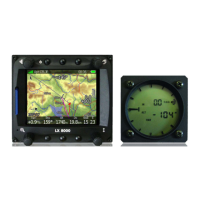LX8000 version 0.96 April 2008
Page 58 of 85
6 Variometer and Altimeter
All signals from the pneumatic sensors (altitude, speed) are derived from high quality
pressure sensors which mean that no flask is necessary. The vario signal is derived from the
altitude signal. All signals are temperature and altitude compensated. A custom
programmable LCD has been designed to display the vario information as well as many other
parameters. Display is user configurable. Variometer can be configured to show:
• range 5 ,10 and 2.5 m/s or 10, 20 and 5 kts
• time constants 0.1s to 5s, in addition there are 4 settings of electronic processing for
the vario signal
• netto vario air mass lift and sink
• relative vario shows the lift or sink that would be achieved if the glider was circled at
thermaling speed
There are two ways by which the vario indications can be corrected for total energy;
electronic TE compensation based on speed changes with time; and pneumatic
compensation with a TE probe. The quality of the TE compensation depends entirely on the
location, size and dimension of the TE tube. The installation must be leak-proof.
If electronic TE compensation is selected, then the TE (P
st
) port should be
connected to a good static pressure source. If pneumatic compensation is
selected, then the TE (P
st
) port should be connected to the TE probe.
6.1 Smart Vario description
The LX system incorporates two configurable electronic filters in the circuitry. The first filter
adjusts the time constant and is adjustable between 0.5 and 5 seconds. The 0.5 setting is
the fastest while the 5 setting provides maximum damping.
The second filter, called the Smart Vario, is a dynamic filter and controls the rate at which
the vario indication moves. When set to OFF, there is no restriction on the rate of movement
of the vario indication other than the setting of the time constant filter. When set to 1, the
vario indication will not move faster than 1 m/s (2kts) per second, while when set to 4, the
vario indication will not move faster than 4 m/s (8kts) per second. It should be noted that
when set to 4, the vario indication will move four times faster than when set to 1.
Summary:
The Smart Vario should not be used in isolation but in conjunction with the setting of the
time constant filter. When the Smart Vario is activated, the time constant filter may need
further adjustment to provide optimum indications.
TE (Pst)
LX8000
Electronic TE com
enstaion
Com
ensation with TE
robe

